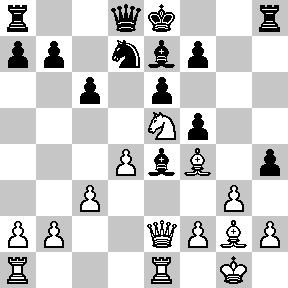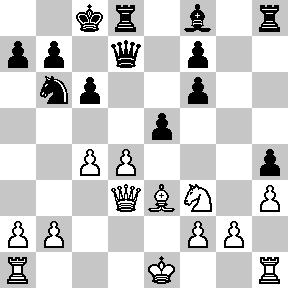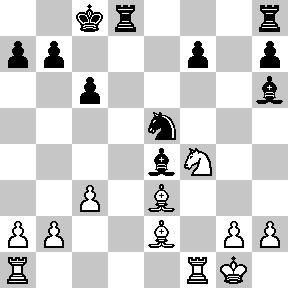Reviving the 5. ... gxf6 Caro-Kann
Popular in the 1970's and 1980's as a result of the work of GMs David Bronstein and Bent Larsen, this eccentric and aggressive variation of the Caro-Kann, characterized by the moves 1. e4 c6 2. d4 d5 3. Nc3 dxe4 4. Nxe4 Nf6 5. Nxf6+ gxf6, fell into utter disuse after a series of blows were dealt to it at the end of the 1980's. It always seemed a real shame to me that such a colorful variation should sink into the shadows of professional chess. In the line, black sacrifices king safety and structure in return for a dynamic center and attacking chances down the open g-file. There's nothing wrong with the idea strategically - afterall the same idea is still commonly played in the Burn French - rather, it appears to be tactically flawed.
The main culprit variation stems from the game Riemersma-Pietersee, Dieren 1989. 1. e4 c6 2. d4 d5 3. Nd2 dxe4 4. Nxe4 Nf6 5. Nxf6+ gxf6 6. c3 Bf5 7. Nf3 e6 8. g3 h5 9. Bg2 Be4 10. 0-0 Be7 11. Re1 f5 12. Qe2! h4 13. Bf4 Nd7 14. Ne5! This variation with 8. g3 has always been considered the best try for white because it slows down black's play on the g-file and black's plan with a quick h5-h4 has been shown to be the most active and assertive reply - if not the only really playable line. The problem is that in the diagrammed position black is in a lot of trouble. Pietersee played 14. ... Bxg2? and ran into the shocking reply 15. Nxf7! Kxf7 16. Qxe6+ winning. If instead he had played 14. ... Nxe5, then 15. Bxe5 f6 16. Bf4 Bxg2 17. Kxg2 follows and white is still much better.
This variation with 8. g3 has always been considered the best try for white because it slows down black's play on the g-file and black's plan with a quick h5-h4 has been shown to be the most active and assertive reply - if not the only really playable line. The problem is that in the diagrammed position black is in a lot of trouble. Pietersee played 14. ... Bxg2? and ran into the shocking reply 15. Nxf7! Kxf7 16. Qxe6+ winning. If instead he had played 14. ... Nxe5, then 15. Bxe5 f6 16. Bf4 Bxg2 17. Kxg2 follows and white is still much better.
Obviously there are other options at black's disposal, but none of them faired much better. If instead 1. e4 c6 2. d4 d5 3. Nd2 dxe4 4. Nxe4 Nf6 5. Nxf6+ gxf6 6. c3 Bf5 7. Nf3 Nd7, as in Campora-Morozevich, Moscow Olympiad 1994, then 8. g3 Nb6 9. Bg2 Qd7 10. 0-0 Bh3 11. Bxh3 Qxh3 12. a4 and black is behind in development, under-represented in the center, and faces the unpleasant task of finding reasonable lodgings for his monarch. Somewhat amusingly, Campora tried to improve on this line for black recently and fared no better than Morozevich did ten years earlier. Fernandez Romero-Campora, Dos Hermanas 2005 went 1. e4 c6 2. d4 d5 3. Nd2 dxe4 4. Nxe4 Nf6 5. Nxf6+ gxf6 6. c3 Bf5 7. Nf3 Nd7 8. g3 Nb6 9. Bg2 Qd7 10. 0-0 0-0-0 11. a4 Nd5 12. Bd2 e6. 13. Re1 Kb8 14. b4 Bg4 15. Qb3 Nc7 16. Bf4 Bd6 17. Bxd6 Qxd6 18. Nd2 and white was much better coordinated and positioned for attack.
Somewhat amusingly, Campora tried to improve on this line for black recently and fared no better than Morozevich did ten years earlier. Fernandez Romero-Campora, Dos Hermanas 2005 went 1. e4 c6 2. d4 d5 3. Nd2 dxe4 4. Nxe4 Nf6 5. Nxf6+ gxf6 6. c3 Bf5 7. Nf3 Nd7 8. g3 Nb6 9. Bg2 Qd7 10. 0-0 0-0-0 11. a4 Nd5 12. Bd2 e6. 13. Re1 Kb8 14. b4 Bg4 15. Qb3 Nc7 16. Bf4 Bd6 17. Bxd6 Qxd6 18. Nd2 and white was much better coordinated and positioned for attack.
Alternatively, 1. e4 c6 2. d4 d5 3. Nd2 dxe4 4. Nxe4 Nf6 5. Nxf6+ gxf6 6. c3 Bf5 7. Nf3 e6 8. g3 Qd5?! 9. Bg2 Qc4 10. Be3 Nd7 11. Bf1!? Qd5 12. Qe2! And black's plan is already unraveling, as he cannot further trouble white's castling scheme on the light squares and he has wasted an inordinate amount of time on queen moves.
And black's plan is already unraveling, as he cannot further trouble white's castling scheme on the light squares and he has wasted an inordinate amount of time on queen moves.
Saddled with the task of choosing among this unpromising array of options, strong players simply gave up the line and it has remained abandoned throughout the 1990's and into the 21st century. In this past year, however, there have been stirrings of interest in the variation and two strong players ventured to experiment in the line. Their contributions are strange to say the least, but the ideas are novel and far from clear. Is it possible that there will yet be a renaissance for the line?
Naiditsch-Seirawan, Dutch Rapid 2005 went 1. e4 c6 2. d4 d5 3. Nd2 dxe4 4. Nxe4 Nf6 5. Nxf6+ gxf6 6. c3 h5!? Here Jeremy Silman offered 7. Bc4 Nd7 8. Ne2 Nb6 9. Bb3 Bg4 10. h3 Bxe2 11. Qxe2 e6 12. Be3 Qc7 with advantage to white in his 1989 book The Dynamic Caro-Kann. This assessment is probably accurate, but there's definitely plenty of fight left in the position, and in any case, there is probably room for improvement in the line. Naiditsch varied with 7. Nf3 h4 8. Bf4 Nd7 9. h3 Nb6 10. c4 Bf5 11. Bd3 Qd7 12. Be3 0-0-0 13. Qc2 Bxd3 14. Qxd3 e5!?
This assessment is probably accurate, but there's definitely plenty of fight left in the position, and in any case, there is probably room for improvement in the line. Naiditsch varied with 7. Nf3 h4 8. Bf4 Nd7 9. h3 Nb6 10. c4 Bf5 11. Bd3 Qd7 12. Be3 0-0-0 13. Qc2 Bxd3 14. Qxd3 e5!? Seirawan's handling of the line is substantially more solid and conservative than the traditional main variations. He certainly has somewhat the weaker central control in the diagrammed position, but it looks like he has good chances for equality and the game was in fact drawn quite easily after 24 moves. Maybe black just needs to take a more relaxed approach?
Seirawan's handling of the line is substantially more solid and conservative than the traditional main variations. He certainly has somewhat the weaker central control in the diagrammed position, but it looks like he has good chances for equality and the game was in fact drawn quite easily after 24 moves. Maybe black just needs to take a more relaxed approach?
Even more interesting (and potentially theoretically significant) was the game Tiviakov-Nisipeanu, FIDE World Championship Libya 2004. It was an important game for the aggressive Romanian grandmaster and it is noteworthy that he opted for the disreputable gxf6 line. The game went 1. e4 c6 2. d4 d5 3. Nd2 dxe4 4. Nxe4 Nf6 5. Nxf6+ gxf6 6. c3 Qd5!? This is a move that Jeremy Silman pointed to in his book as a possible area for future exploration, but very little work has been done on it in the intervening years. It is strange in that black's queen should be exposed in the center, but instead, it appears that it helps to quiet down white's initiative and buy time for black to unwind. The game continued 7. Ne2 e5 8. Be3 Be6 9. f4 Nd7 10. dxe5 fxe5 11. Qxd5 Bxd5 12. fxe5 Nxe5 13. Nf4 Be4 14. Be2 0-0-0 15. 0-0 Bh6 where black had the technical structural problem of isolated pawns on the kingside, but somewhat made up for it with attacking chances down the g-file. The diagrammed position was probably not far from even. One older game also demonstrated the viability of this line for black, suggesting that perhaps it is really a fully acceptable and quite playable alternative to the old lines. Spassky-Seirawan, Barcelona 1989 1. e4 c6 2. d4 d5 3. Nd2 dxe4 4. Nxe4 Nf6 5. Nxf6+ gxf6 6. c3 Qd5!? 7. Ne2 e5 8. Be3 Be6 9. Qe2 Nd7 10. a3 0-0-0 11. 0-0-0 Nb6 12. dxe5 Qxd1+ 13. Qxd1 Rxd1+ 14. Kxd1 fxe5 15. Ng3 f5 16. Bd3 e4 17. Be2 c5 18. Nh5 1/2-1/2
where black had the technical structural problem of isolated pawns on the kingside, but somewhat made up for it with attacking chances down the g-file. The diagrammed position was probably not far from even. One older game also demonstrated the viability of this line for black, suggesting that perhaps it is really a fully acceptable and quite playable alternative to the old lines. Spassky-Seirawan, Barcelona 1989 1. e4 c6 2. d4 d5 3. Nd2 dxe4 4. Nxe4 Nf6 5. Nxf6+ gxf6 6. c3 Qd5!? 7. Ne2 e5 8. Be3 Be6 9. Qe2 Nd7 10. a3 0-0-0 11. 0-0-0 Nb6 12. dxe5 Qxd1+ 13. Qxd1 Rxd1+ 14. Kxd1 fxe5 15. Ng3 f5 16. Bd3 e4 17. Be2 c5 18. Nh5 1/2-1/2
The main culprit variation stems from the game Riemersma-Pietersee, Dieren 1989. 1. e4 c6 2. d4 d5 3. Nd2 dxe4 4. Nxe4 Nf6 5. Nxf6+ gxf6 6. c3 Bf5 7. Nf3 e6 8. g3 h5 9. Bg2 Be4 10. 0-0 Be7 11. Re1 f5 12. Qe2! h4 13. Bf4 Nd7 14. Ne5!
 This variation with 8. g3 has always been considered the best try for white because it slows down black's play on the g-file and black's plan with a quick h5-h4 has been shown to be the most active and assertive reply - if not the only really playable line. The problem is that in the diagrammed position black is in a lot of trouble. Pietersee played 14. ... Bxg2? and ran into the shocking reply 15. Nxf7! Kxf7 16. Qxe6+ winning. If instead he had played 14. ... Nxe5, then 15. Bxe5 f6 16. Bf4 Bxg2 17. Kxg2 follows and white is still much better.
This variation with 8. g3 has always been considered the best try for white because it slows down black's play on the g-file and black's plan with a quick h5-h4 has been shown to be the most active and assertive reply - if not the only really playable line. The problem is that in the diagrammed position black is in a lot of trouble. Pietersee played 14. ... Bxg2? and ran into the shocking reply 15. Nxf7! Kxf7 16. Qxe6+ winning. If instead he had played 14. ... Nxe5, then 15. Bxe5 f6 16. Bf4 Bxg2 17. Kxg2 follows and white is still much better.Obviously there are other options at black's disposal, but none of them faired much better. If instead 1. e4 c6 2. d4 d5 3. Nd2 dxe4 4. Nxe4 Nf6 5. Nxf6+ gxf6 6. c3 Bf5 7. Nf3 Nd7, as in Campora-Morozevich, Moscow Olympiad 1994, then 8. g3 Nb6 9. Bg2 Qd7 10. 0-0 Bh3 11. Bxh3 Qxh3 12. a4 and black is behind in development, under-represented in the center, and faces the unpleasant task of finding reasonable lodgings for his monarch.
 Somewhat amusingly, Campora tried to improve on this line for black recently and fared no better than Morozevich did ten years earlier. Fernandez Romero-Campora, Dos Hermanas 2005 went 1. e4 c6 2. d4 d5 3. Nd2 dxe4 4. Nxe4 Nf6 5. Nxf6+ gxf6 6. c3 Bf5 7. Nf3 Nd7 8. g3 Nb6 9. Bg2 Qd7 10. 0-0 0-0-0 11. a4 Nd5 12. Bd2 e6. 13. Re1 Kb8 14. b4 Bg4 15. Qb3 Nc7 16. Bf4 Bd6 17. Bxd6 Qxd6 18. Nd2 and white was much better coordinated and positioned for attack.
Somewhat amusingly, Campora tried to improve on this line for black recently and fared no better than Morozevich did ten years earlier. Fernandez Romero-Campora, Dos Hermanas 2005 went 1. e4 c6 2. d4 d5 3. Nd2 dxe4 4. Nxe4 Nf6 5. Nxf6+ gxf6 6. c3 Bf5 7. Nf3 Nd7 8. g3 Nb6 9. Bg2 Qd7 10. 0-0 0-0-0 11. a4 Nd5 12. Bd2 e6. 13. Re1 Kb8 14. b4 Bg4 15. Qb3 Nc7 16. Bf4 Bd6 17. Bxd6 Qxd6 18. Nd2 and white was much better coordinated and positioned for attack.Alternatively, 1. e4 c6 2. d4 d5 3. Nd2 dxe4 4. Nxe4 Nf6 5. Nxf6+ gxf6 6. c3 Bf5 7. Nf3 e6 8. g3 Qd5?! 9. Bg2 Qc4 10. Be3 Nd7 11. Bf1!? Qd5 12. Qe2!
 And black's plan is already unraveling, as he cannot further trouble white's castling scheme on the light squares and he has wasted an inordinate amount of time on queen moves.
And black's plan is already unraveling, as he cannot further trouble white's castling scheme on the light squares and he has wasted an inordinate amount of time on queen moves.Saddled with the task of choosing among this unpromising array of options, strong players simply gave up the line and it has remained abandoned throughout the 1990's and into the 21st century. In this past year, however, there have been stirrings of interest in the variation and two strong players ventured to experiment in the line. Their contributions are strange to say the least, but the ideas are novel and far from clear. Is it possible that there will yet be a renaissance for the line?
Naiditsch-Seirawan, Dutch Rapid 2005 went 1. e4 c6 2. d4 d5 3. Nd2 dxe4 4. Nxe4 Nf6 5. Nxf6+ gxf6 6. c3 h5!? Here Jeremy Silman offered 7. Bc4 Nd7 8. Ne2 Nb6 9. Bb3 Bg4 10. h3 Bxe2 11. Qxe2 e6 12. Be3 Qc7 with advantage to white in his 1989 book The Dynamic Caro-Kann.
 This assessment is probably accurate, but there's definitely plenty of fight left in the position, and in any case, there is probably room for improvement in the line. Naiditsch varied with 7. Nf3 h4 8. Bf4 Nd7 9. h3 Nb6 10. c4 Bf5 11. Bd3 Qd7 12. Be3 0-0-0 13. Qc2 Bxd3 14. Qxd3 e5!?
This assessment is probably accurate, but there's definitely plenty of fight left in the position, and in any case, there is probably room for improvement in the line. Naiditsch varied with 7. Nf3 h4 8. Bf4 Nd7 9. h3 Nb6 10. c4 Bf5 11. Bd3 Qd7 12. Be3 0-0-0 13. Qc2 Bxd3 14. Qxd3 e5!? Seirawan's handling of the line is substantially more solid and conservative than the traditional main variations. He certainly has somewhat the weaker central control in the diagrammed position, but it looks like he has good chances for equality and the game was in fact drawn quite easily after 24 moves. Maybe black just needs to take a more relaxed approach?
Seirawan's handling of the line is substantially more solid and conservative than the traditional main variations. He certainly has somewhat the weaker central control in the diagrammed position, but it looks like he has good chances for equality and the game was in fact drawn quite easily after 24 moves. Maybe black just needs to take a more relaxed approach?Even more interesting (and potentially theoretically significant) was the game Tiviakov-Nisipeanu, FIDE World Championship Libya 2004. It was an important game for the aggressive Romanian grandmaster and it is noteworthy that he opted for the disreputable gxf6 line. The game went 1. e4 c6 2. d4 d5 3. Nd2 dxe4 4. Nxe4 Nf6 5. Nxf6+ gxf6 6. c3 Qd5!? This is a move that Jeremy Silman pointed to in his book as a possible area for future exploration, but very little work has been done on it in the intervening years. It is strange in that black's queen should be exposed in the center, but instead, it appears that it helps to quiet down white's initiative and buy time for black to unwind. The game continued 7. Ne2 e5 8. Be3 Be6 9. f4 Nd7 10. dxe5 fxe5 11. Qxd5 Bxd5 12. fxe5 Nxe5 13. Nf4 Be4 14. Be2 0-0-0 15. 0-0 Bh6
 where black had the technical structural problem of isolated pawns on the kingside, but somewhat made up for it with attacking chances down the g-file. The diagrammed position was probably not far from even. One older game also demonstrated the viability of this line for black, suggesting that perhaps it is really a fully acceptable and quite playable alternative to the old lines. Spassky-Seirawan, Barcelona 1989 1. e4 c6 2. d4 d5 3. Nd2 dxe4 4. Nxe4 Nf6 5. Nxf6+ gxf6 6. c3 Qd5!? 7. Ne2 e5 8. Be3 Be6 9. Qe2 Nd7 10. a3 0-0-0 11. 0-0-0 Nb6 12. dxe5 Qxd1+ 13. Qxd1 Rxd1+ 14. Kxd1 fxe5 15. Ng3 f5 16. Bd3 e4 17. Be2 c5 18. Nh5 1/2-1/2
where black had the technical structural problem of isolated pawns on the kingside, but somewhat made up for it with attacking chances down the g-file. The diagrammed position was probably not far from even. One older game also demonstrated the viability of this line for black, suggesting that perhaps it is really a fully acceptable and quite playable alternative to the old lines. Spassky-Seirawan, Barcelona 1989 1. e4 c6 2. d4 d5 3. Nd2 dxe4 4. Nxe4 Nf6 5. Nxf6+ gxf6 6. c3 Qd5!? 7. Ne2 e5 8. Be3 Be6 9. Qe2 Nd7 10. a3 0-0-0 11. 0-0-0 Nb6 12. dxe5 Qxd1+ 13. Qxd1 Rxd1+ 14. Kxd1 fxe5 15. Ng3 f5 16. Bd3 e4 17. Be2 c5 18. Nh5 1/2-1/2

3 Comments:
Dude... if game starts 1. e4 e6 2. d4 d5 3. Nc3 pxp 4. NxP Qd5 5. Bd3 Nf6 6. NxN gxf6 and black reaches a position similar to the ...gxf6 caro variation - so you don't even need to play the caro, to reach these type of posiitons
Thanks for nice survey of gf6 developments. The move Qd5 seems like an improvement, but it doesn't seem to be as much fun.
I find the strategic idea behind this variation quite appealing.
Post a Comment
<< Home